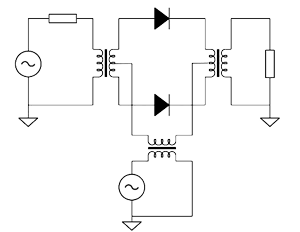Analysis of diode mixers using nodal voltage method in generalized matrix form in frequency domain. Part 1: Transfer function
DOI:
https://doi.org/10.3103/S0735272722020030Abstract
This paper presents the method for analysis of diode frequency converters in the basis of nodal voltages employing the generalized matrix form in the frequency domain. Theoretical expressions for the transfer function of three (balanced, double-balanced and triple-balanced) circuits of diode frequency converters were obtained based on the specified method. Expressions for estimating the maximum attainable values of the transfer function were presented. The relationships of the mixer transfer ratios as a function of the load resistance and heterodyne voltage amplitude were also obtained. It has been shown that the variation of values of the load resistance and heterodyne voltage amplitude makes it possible to maximize the mixer transfer function. The presented results of simulating three circuits of diode frequency converters confirm the high accuracy of calculations. The possible error does not exceed 3 dB. The results of calculations and simulation are presented for two operating modes: heterodyne harmonic signal (non-intensive mode) and heterodyne pulse signal (intensive mode).
References
- C. Bose, R. Pal, M. K. Mandai, “Design of a wideband down-conversion mixer in X-band,” in 2018 3rd International Conference on Microwave and Photonics (ICMAP), 2018, pp. 1–2, doi: https://doi.org/10.1109/ICMAP.2018.8354596.
- S. Pegwal, M. P. Abegaonkar, A. Basu, S. K. Koul, “Single balanced mixer for UWB applications,” in 2018 IEEE International Symposium on Radio-Frequency Integration Technology (RFIT), 2018, pp. 1–3, doi: https://doi.org/10.1109/RFIT.2018.8524103.
- M. N. Do, D. Langrez, J.-F. Villemazet, J.-L. Cazaux, “Double and triple balanced wideband mixers integrated in GaAs technology,” in 2010 Workshop on Integrated Nonlinear Microwave and Millimeter-Wave Circuits, 2010, pp. 85–88, doi: https://doi.org/10.1109/INMMIC.2010.5480129.
- S. T. Choi, Y. J. Kim, Y. H. Kim, D. H. Lee, C. T. Choi, “A novel uniplanar ultra-broadband double doubly balanced mixer for high dynamic range applications,” in 2009 European Microwave Conference (EuMC), 2009, pp. 65–68, doi: https://doi.org/10.23919/EUMC.2009.5295994.
- K. Pushpa, P. Mondal, A. Singh, “A dual-band subharmonic mixer with high RF-IF isolation,” in 2017 Progress in Electromagnetics Research Symposium - Fall (PIERS - FALL), 2017, pp. 1183–1189, doi: https://doi.org/10.1109/PIERS-FALL.2017.8293312.
- J.-C. Kao, K.-Y. Lin, C.-C. Chiong, C.-Y. Peng, H. Wang, “A W-band high LO-to-RF isolation triple cascode mixer with wide IF bandwidth,” IEEE Trans. Microw. Theory Tech., vol. 62, no. 7, pp. 1506–1514, 2014, doi: https://doi.org/10.1109/TMTT.2014.2323020.
- W. Mohyuddin, G. H. Lee, D. H. Kim, I. B. Kim, H. C. Choi, K. W. Kim, “A compact double-balanced diode ring mixer for wideband applications,” in 2018 48th European Microwave Conference (EuMC), 2018, pp. 648–651, doi: https://doi.org/10.23919/EuMC.2018.8541547.
- M. Hrobak, W. Stein, M. Sterns, M. Schramm, L.-P. Schmidt, “A hybrid broadband microwave triple balanced mixer based on silicon crossed quad diodes,” in 2012 42nd European Microwave Conference, 2012, pp. 5–8, doi: https://doi.org/10.23919/EuMC.2012.6459257.
- W. Yun, V. Sundaram, M. Swaminathan, “A triple balanced mixer in multi-layer Liquid Crystalline Polymer (LCP) substrate,” in 2007 Proceedings 57th Electronic Components and Technology Conference, 2007, pp. 2000–2005, doi: https://doi.org/10.1109/ECTC.2007.374076.
- A. S. Korotkov, “Double-balanced mixer based on MOSFETs,” Russ. Microelectron., vol. 40, no. 2, pp. 128–140, 2011, doi: https://doi.org/10.1134/S1063739711020053.
- H.-K. Chiou, H.-H. Lin, “A miniature MMIC double doubly balanced mixer using lumped dual balun for high dynamic receiver application,” IEEE Microw. Guid. Wave Lett., vol. 7, no. 8, pp. 227–228, 1997, doi: https://doi.org/10.1109/75.605486.
- T. N. Ton et al., “An X-band monolithic double double-balanced mixer for high dynamic receiver application,” in IEEE Symposium on Microwave and Millimeter-Wave Monolithic Circuits, 1990, pp. 115–118, doi: https://doi.org/10.1109/MCS.1990.110952.
- E. Camargo, B. Henderson, Microwave Mixer Technology and Applications. Boston: Artech House, 2013, uri: https://uk.artechhouse.com/Microwave-Mixer-Technology-and-Applications-P1592.aspx.
- B. M. Bogdanovich, Nonlinear Distortions in Receiver-Amplifying Devices, [in Russian]. Moscow: Svyaz, 1980.
- B. M. Bogdanovich, Methods of Nonlinear Functionals in the Electrocommunication Theory, [in Russian]. Moscow: Radio i Svyaz’, 1990.
- Y. Shapovalov, D. Bachyk, R. Romaniuk, I. Shapovalov, “Parametric matrix models of parametric circuits and their elements in frequency domain,” Radioelectron. Commun. Syst., vol. 64, no. 8, pp. 413–425, 2021, doi: https://doi.org/10.3103/S0735272721080021.
- N. Vitee, H. Ramiah, P.-I. Mak, J. Yin, R. P. Martins, “A 3.15-mW +16.0-dBm IIP3 22-dB CG inductively source degenerated balun-LNA mixer with integrated transformer-based gate inductor and IM2 injection technique,” IEEE Trans. Very Large Scale Integr. Syst., vol. 28, no. 3, pp. 700–713, 2020, doi: https://doi.org/10.1109/TVLSI.2019.2950961.
- M. Mollaalipour, H. Miar-Naimi, “Design and analysis of a highly efficient linearized CMOS subharmonic mixer for zero and low-IF applications,” IEEE Trans. Very Large Scale Integr. Syst., pp. 1–11, 2016, doi: https://doi.org/10.1109/TVLSI.2015.2504486.
- A. Ebrahimi, M. J. Hemmati, A. Hakimi, K. Afrooz, “A new low-power and high-linearity CMOS bulk-injection mixer in 0.13 um technology,” in Electrical Engineering (ICEE), Iranian Conference on, 2018, pp. 108–113, doi: https://doi.org/10.1109/ICEE.2018.8472644.
- J. Jiang, D. M. Holburn, “Design and analysis of a low-power highly linear mixer,” in 2009 European Conference on Circuit Theory and Design, 2009, pp. 675–678, doi: https://doi.org/10.1109/ECCTD.2009.5275084.
- V. Gutta, T. Fattorini, A. Parker, “Intermodulation nulling in anti-parallel diode pair mixers,” in 2006 Asia-Pacific Microwave Conference, 2006, pp. 461–464, doi: https://doi.org/10.1109/APMC.2006.4429463.
- A. Korotkov, O. Golovan, “Theory and analysis of the diode frequency mixers: generalized matrix approach (Part I: transfer function),” in 2021 International Symposium on Signals, Circuits and Systems (ISSCS), 2021, pp. 1–6, doi: https://doi.org/10.1109/ISSCS52333.2021.9497445.
- J. L. Stewart, Circuit Theory and Design. Hoboken, NJ: John Wiley & Sons, 1956, uri: https://www.amazon.com/Circuit-Theory-Design-John-Stewart/dp/B0000CJKQA.


